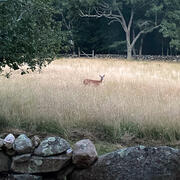Pollinators
Pollinators
Filter Total Items: 25
EESC Makes an Impact: Empowering State-led Wildlife Management
Management of state natural resources is a collaborative effort between state governments, federal agencies, tribal governments, and local stakeholders. USGS Eastern Ecological Science Center (EESC) supports state-led wildlife management with research that clarifies complex issues, enhances scientific quality and communication, broadens solution options, and enables cost-sharing and mutual...
Key Values of a Century of EESC Science
The USGS Eastern Ecological Science Center (EESC) is rooted in a proud tradition of service to the nation—advancing science that informs the conservation and management of fish, wildlife, and habitats across the eastern United States and beyond. Our mission is clear: deliver reliable, partner-driven science that supports natural resource decisions today, while ensuring these resources remain...
EESC Makes an Impact: Protecting Ecosystems to Safeguard Food and Water
Research at the USGS Eastern Ecological Science Center (EESC) supports understanding of the connection between ecosystem health and the quality and availability of America's food and water. USGS studies help monitor and assess the health of terrestrial and aquatic ecosystems, species populations, water quality, and contaminants affecting health and habitats. Information gained through this...
Agricultural Practices
Agricultural lands account for more than 50% of the lower 48 states and the effects of agricultural land use reach beyond individual fields and farms affecting terrestrial and migratory wildlife. Thus, it is important to know what long-term benefits US Department of Agriculture (USDA) conservation programs and policies have on wildlife habitat and the American public. The USDAs Conservation...
Advancing the Environmental DNA Toolkit for Ecosystem Monitoring and Management
The emerging field of Environmental DNA (eDNA) analysis allows characterization of species presence and community biodiversity by identifying trace amounts of genetic material left behind as organisms move through their environments. EESC scientists have been using eDNA technologies to detect native and rare species and as community biomonitoring tools.
Using Pollinator Environmental DNA to Assess the Ecological Resilience of America’s Grasslands
Scientists from six USGS science centers are collaborating with USDA, university, and Tribal partners, and Department of the Interior land managers, to assess the status of pollinator communities and the distribution of species of conservation concern using environmental DNA. These methods will be used to improve assessments of habitat quality and pollinator responses to restoration, including...
By
Species Management Research Program, Eastern Ecological Science Center, Forest and Rangeland Ecosystem Science Center, Great Lakes Science Center, Northern Prairie Wildlife Research Center, Northern Rocky Mountain Science Center, Upper Midwest Environmental Sciences Center, Pacific Northwest Environmental DNA Laboratory
Conservation Genetics of the Hawaiian Hoary Bat
The Hawaiian Hoary Bat ( Lasiurus semotus) or ʻōpeʻapeʻa is the only extant land mammal native to the Hawaiian archipelago and is listed as endangered due to apparent population declines, and a lack of knowledge concerning its distribution, abundance, and habitat needs. This study is designed to apply molecular techniques to document demographic information, assess genetic variability, describe...
Using Artificial Flowers to Survey for Pollinators
Pollinators, such as bees and butterflies, are critical for the success of agriculture and must have suitable habitat to thrive. Planting pollinator-friendly plants under and around solar panels has the potential to benefit pollinators and nearby agriculture while contributing to renewable energy production.
Determining the dietary preferences and population genetics of an endangered bumble bee, Bombus affinis, by maximizing the use of museum specimens
Bombus affinis, the rusty patched bumble bee, was federally listed as an endangered species in 2017 and has been identified as one of the top priority species for recovery nationally. Shortly after listing the species, the U.S. Fish and Wildlife Services and other partners prioritized the research needed to prevent the extinction of B. affinis. Some of the top research needs that were identified...
Western Bumble Bee and Native Pollinator Research
The western bumble bee was historically one of the most common bumble bees across the western U.S. and Canada. However, our research and others found it has declined substantially across its range and the U.S. Fish and Wildlife Service is considering it for listing under the Endangered Species Act. Bureau of Land Management, National Park Service, and other land managers need information to inform...
Improving Forage for Honey Bees on USDA Conservation Lands: A Pilot Study for Testing Sampling Methods and Hypothesis Development
Commercial beekeepers have been bringing their bees to the Northern Great Prairie (NGP) for many decades due to the availability of nectar and pollen-rich plants in abundant grasslands.
Evaluation of conservation grazing versus prescribed fire to manage tallgrass prairie remnants for plant and pollinator species diversity
With scarcely 2% of native tallgrass prairie remaining today, it is imperative that we wisely manage what little remains to conserve prairie-dependent plants, pollinators, other animals and ecosystem processes. Two commonly used methods of prairie management are prescribed fire and conservation grazing. Either method may present trade-offs with respect to conservation of vulnerable plant, bee or...













